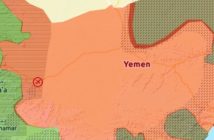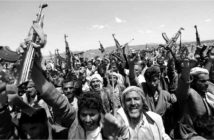The grassroots of the crisis and war in Yemen may be attributed to the failure by the Republic of Yemen in establishing an equal citizenship for all Yemenis. The young state which was created by the merger of two states of authoritarian regimes in 1990 has inherited two different experiments within the same territory. In the northwest, was the regime of the Arab Yemen Republic which was established after the revolution of the 26th of September in 1962 that broke out against the Mutawakkilite Imamate monarchy, which used to rule Yemen as if it were still in the middle ages.
Indeed, the republican regime was established following a protracted civil war that lasted 8 years in the north. It had produced a political system that generated a serious political dilemma in the northern part of Yemen. The problem became the dominance by the northern tribes over authority. The fact is that although the republican regime had overthrown the Imamate theocratic and sectarian-ethnic based regime monarchy, it had largely failed to establish a national regime and the state institutions.
What happened was that the spiritual leadership of the Hashemite political elite was replaced by tribal leadership, which consisted mainly of the Sheikhs of the northern tribes, their military personnel and some of the leading businessmen also were engaged. Meanwhile the central and southern regions were seriously marginalized. The tendency was further enhanced when the former president Ali Saleh assumed the top office for the first time in 1978. Saleh concentrated almost all power in his own tribe and family.
During the 33 years of his rule, Saleh appointed his relatives to every high ranking position in the military, security, political, economic and financial sectors. Prior to the country’s reunification in May 1990, Saleh forged wide-ranging alliances with tribal leaders, the Muslims Brethren and businessmen. The Unity was ill-planned, lacked good preparation and was achieved too hastily. The northern regime along with the Yemeni Socialist Party, the ruling party at that time in the southeast of the country, did not make the correct and necessary arrangements to ensure sustainable unification.
So, not long after, the unification turned out to be a catastrophic setback: a brief civil war broke out just four years later. The 1994 civil war resulted in a deep chasm between the south and the north, and most importantly it has further exacerbated the citizenship crisis. The war also caused one more crisis concerning the political identity of the country. Therefore, a pro-separation movement emerged in the south of the country as a reaction to the marginalization practices by the northern political elite in Sana’a.
The political regime, which was established in the south after the independence in 1967, was an authoritarian police state. However, the Aden-based socialist regime could bring some 20 sultanates and sheikdoms together in one single state. So, the southern regime had sought for the unity of the country with good faith. But the failure of the reunification has revived the old regional sentiments that had nearly disappeared in the southern governorates.
Though the Yemeni single state has opted for democracy and a multi-party political system, in the wake of the 1994 civil war, the regime led by ex-president Saleh tended to monopolise power. Internal strife started to appear among the northern elite when key players realized that the country’s limited resources can no longer be shared with others. Then, Saleh acted to exclude the Islamists and aimed to undermine the tribal coalition headed by Sheikh Al-Ahmar. That means that Saleh initiated the second phase which aimed to overcome his allies of the influential military and tribal figures. He actually wanted to pave the way for his son Ahmed Ali who was appointed as the commander of the republican guard’s troops, the elite of Yemeni and counter-terrorism forces. As a result, a serious polarization process increased among the military and tribal institutions. These developments coincided with an explosion of the citizenship and integration crisis that was clearly manifested by Al-Houthi’s movement in Sa’ada and the Southern movement in the south in 2007.
The rampant corruption, and the rise of control of public resources by the conflicting political elites, in addition to the free market policies, further increased the burden on the vast majority of the population. Yemen was designated for a revolution prior to the popular uprisings that swept several countries in the Arab world in 2011. The Yemeni popular uprising erupted in February 2011. Because of the division among the ruling elite and military institution, a regime change was very likely, and bringing drastic transformation seemed possible.
However, the GGC-brokered deal brought about redistribution of power between the opposition and Saleh’s regime. In other words, they wanted to bring back the same ruling elite. Against this background, an ineffective unity government was established that largely failed to bring about tangible reforms, let alone to satisfy people’s aspirations. For these reasons, the ordinary people sought for shelter under their traditional structures and entities. This is why we have seen ex-president Saleh join the Houthis even though he fought six wars against them, and despite that the Houthis were among protesters against Saleh regime in 2011.
They have a common interest as long as they are from the same northern tribal region. So, they sensed that there was an intention to marginalize them together. Besides that, the Houthis have sought to regain the Imamate ruling, and Saleh wanted to take revenge against his opponents, so it was not a surprise for them to forge an alliance. Yemen’s strategic location has also something to do with the regional conflicts, mainly between Saudi Arabia and Iran.
In conclusion, though regional competition has helped to fuel the Yemeni conflicts and made the country a battlefield for regional war, the grassroots of the Yemeni crisis and war are deeply rooted in Yemen’s history and social structure.





1 Comment
Well Yemen crisis is multi- national interference by the neighboring countries and Geo-political powers.